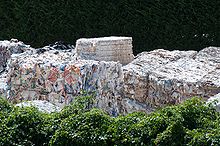Waste paper stock
The pulp produced from waste paper , which is used for the production of paper , cardboard and cardboard , is called waste paper stock or secondary fiber . Depending on the source and purity of the waste paper, a distinction is made between deinked and non-deinked waste paper stock.
As a secondary fiber (recycled fiber), waste paper stock is fundamentally differentiated from wood pulp and cellulose . These primary fibers are obtained from wood, cellulose to a lesser extent from other plants. Wood pulp and cellulose fibers are referred to as primary fibers or fresh fibers.
Papers are often made from a mixture of waste paper and fresh fibers (i.e. wood pulp and / or cellulose). Packaging cardboard, newsprint and toilet paper are partly made from 100% recycled paper. The manufacturers of these types of paper are the main buyers of waste paper.
The share of recovered paper used in the total domestic production of paper, cardboard and paperboard is known as the recovered paper use quota . This quota rose continuously in Germany from 60% in 1996 to 75% in 2016. Recovered paper stock is thus the most important fiber in the paper industry in terms of quantity .
See also
Individual evidence
- ^ Verband Deutscher Papierfabriken eV: Paper ABC (PDF), as of 2015, keyword waste paper .
- ^ Association of German Paper Mills eV: Paper ABC (PDF), as of 2015, cf. Keywords primary fibers and secondary fibers .
- ↑ Zellstoff- und Papierindustrie umweltbundesamt.de, see section paper manufacture .
- ^ Association of German Paper Mills eV: Paper ABC (PDF), as of 2015, keyword recycled paper .
- ^ A b Association of German Paper Mills eV: Paper ABC (PDF), as of 2015, keyword waste paper .
- ↑ Altpapier Umweltbundesamt.de
